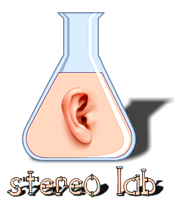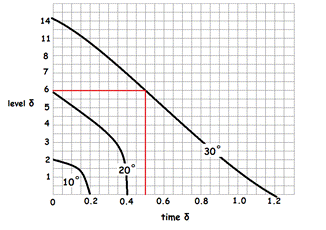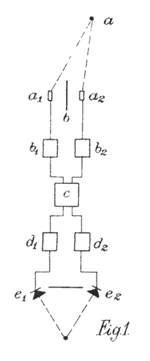
Fig. 16 - Theory of spaced omnidirectional microphones as a stereo pair

To buy the book from which this article came (as a paper or as a Kindle book) go here.
Because rock musicians and producers hold great store in the creation of entirely artificial (synthetic) sound worlds, a multi-microphone technique is preferred. On the other hand, in a classical-music recording, whilst possible in principle to mike-up every instrument within an orchestra and then - with a combination of multi-track and electronic panning - create a stereo picture of the orchestra, this is usually not done. Partly because the technique is very costly and complicated and secondly, because this multi-miked technique has not found favour amongst classical music aficionados, all of whom agree that it fails to provide a faithful representation of the experience of listening to an orchestra in a concert hall.
The exception to minimalist techniques for orchestral recordings sometimes exists in recording orchestral music for moving-pictures. For various, practical and artistic reasons, film scores are often recorded using a multi-track technique in which every instrumental group (and sometimes almost every instrument), is allocated its own microphone and fader. As with all close miking, this has the effect of heightening each instrument's character resulting in a "hyper-realist" and deeply dramatic rendering of the orchestra. Adopting this technique results in a recorded sound in which there is less blend: bowed double basses rasp and thunder, strings sigh, brasses blare, and woodwinds are breathy and plangent. The result is a mannered style which complements the heightened nature of cinema images.
Obviously some logistical situations militate against the use of multi-microphone technique. That such a technique would not work for a recording of the dawn chorus should go without saying! With the notable exception of sound recording for cinema films, most historical recordings of orchestras and choirs depended almost exclusively on the application of simple, or "purist" microphone techniques where the majority of the signal that went onto the master tape or disc were derived from just a few microphones. It may be said with certainty that the orthodox canon of classical recordings were made this way. Sadly recent fashion has tended to encourage the use of cinematographic, multi-miked techniques for "serious" recordings in an attempt to rejuvenate the rather limited repertoire of classical music. But fashions change, and no doubt they will again. And "purist" microphone techniques will be there when they do.
Surprisingly there are no fixed rules as to how these main microphones should be arranged in these "minimalist" recording techniques; although a number of popular deployments have evolved over years and these are discussed below.

There is a "golden rule" for the deployment of spaced omnidirectional microphones called the 3:1 rule. This tenet states that for every one unit of distance from the artists to the line of the microphones, there must be three units of distance between the two microphones. For orchestral recording, this implies one metre separation when, operating just behind the conductor. Any greater separation than this and a "hole in the middle" appears in which the centre of the stereo stage recedes with respect to the sides, requiring a centre microphone to reinforce the middle. The pair should be rigged about 2 metres high.
The theory behind this technique is illustrated in Figure 16. Each omnidirectional (pressure sensitive) microphone simply transduces either the left channel signal, or the right-channel signal. This technique captures the position of a particular instrumentalist by means of time-differences between the signals arriving at the microphones. The signal from each microphone should be panned hard left or right as appropriate, or recorded directly to the left and right channels of the stereo master. Recordings using this technique suffer from a slightly vague stereo effect because the technique relies on capturing time-of-arrival cues and not amplitude cues on which stereo ultimately depends. Nevertheless, this technique ensures that the left and right signals are un-correlated and this leads to a "warm and wet" signal with pleasing reverb and ambience. Furthermore, this technique enables the recording engineer to use omnidirectional microphones which do not require the compromises in design that we noted with cardioid types. Cardioid microphones never seem to offer quite the "openness" of an omnidirectional microphone and this reason alone has kept spaced omni's a favourite with many recording institutions and engineers. Fortunately there are electronic matrix techniques for capturing a sharp stereo image from spaced-omni's as discussed below; although these are not well known.


The ideal response of a velocity microphone is given by |cos θ | where θ is the angle of incidence of the sound wave upon the microphone. An ideal polar response of two cosine microphones mounted at 90 degrees to one another and at 45 degrees each side of the sound-stage is illustrated in Figure 18.
If it were possible to fabricate a perfect velocity microphone with a perfect cosine polar response at all frequencies, it would represent an almost perfect encode system for the capture of real, acoustic sounds for replay over loudspeakers. Such a microphone array would be - in effect - an acoustic sine/cosine pan-control as illustrated in Figure 19. The theory of stereo is covered in much greater detail in chapter 18. For the moment, simply note that, at 30 degrees off centre (which is the usual loudspeaker position - and hence the practical limit of the stereo soundstage), the ratio between the wanted "live" channel and the "dead" channel is about three to one. And, at the extremes of the stereo stage, the response from the "dead" channel is suppressed entirely. Crossed figure-of-eights may legitimately be termed "Blumlein technique" since most of his team's later work on stereo was conceived with crossed-cosine microphones.

Unfortunately, all figure-of-eight microphones tend to "beam" and become more directional with frequency. An example of the polar response of a practical microphone is given in Figure 20. This represents a very good performance, and many practical examples show a more pronounced effect than this.

The result of this narrowing of the high-frequency response will be to exaggerate HF cues with respect to LF cues because - for a given obliquity ( θ ), a greater inter-channel ratio will be encoded at HF than at LF. This will lead to distortion of the HF image which will bias side-response with respect to centre-response. This too may be corrected electronically although this is rarely done in contemporary practice.
There is a further, gross distortion which is introduced by crossed, figure-of-eight microphones. This is that the rear-arc is encoded and re-mapped, in a mirror-image form, onto the forward arc. The practical result of this is the collection of a greater reverberation signal, which is distorted in as much as it appears from in-front and reversed in L/R sense.
In order to address the limitation noted in relation to crossed, velocity microphones and their characteristic of encoding the entire 360o soundstage, recording engineers have developed versions of the coincident microphone technique using cardioids which, by their nature, reject sound from the rear of the capsules. In usual deployments, the microphones are rigged on sturdy stands about two metres or more above the performance area floor and pointing slightly down. But to what extent is the response pattern of the cardioid microphone suitable for accurate stereo encoding?

The theoretical response of a cardioid is given by (1 + cos θ ) where θ is the angle of incidence of the sound wave. This curve is plotted in Figure 21 and the curves for two, superimposed cardioid responses at ninety degrees to one another are plotted in Figure 22.

The curves of Figure 22 are translated from polar form to rectangular form in Figure 23, so that they may be compared with the ideal panning laws of the pan-pot and the crossed cosine microphone array which were illustrated in Figure 19.

As can clearly be seen, the crossed-cardioid arrangement will fail to produce adequate levels of inter-channel level difference at θ = ±30 degrees from centre. The inter-channel ratio (upper curves) is a less than 0.7:1 at 30 degrees from the centre; wholly inadequate for proper stereo encoding at low and middle frequencies. In fact, the only reason crossed cardioids give an adequate stereo effect is due to HF beaming effects (shown as the lower curves in Figure 23). This data is empirical and indicates that HF beaming effects create greatly exaggerated inter-channel ratios at high-frequencies. These results were measured from a selection of practical, recording microphones.


One way out of this impasse is to arrange cardioids at an angle greater than 90 degrees with respect to one another, as is illustrated in Figure 24. This has the advantage that adequate inter-channel ratio is provided, but the microphones are so widely set that the stereo image is badly compressed laterally.
From the above we can conclude that crossed cardioids will provide insufficient level differences to provide correct stereo reproduction over loudspeakers at low and middle frequencies (<1kHz). This fact alone accounts for the lack of "spaciousness" or "low-frequency bloom" so often attributed to this microphone arrangement. It is also incorrect to refer to crossed-cardioids as "Blumlein technique" since he never - and surely never would have - endorsed such an approach.
Another, intuitive way to comprehend why crossed-cardioids are not an accurate way to encode stereo information is to consider each cardioid microphone as a combination of a cosine (eight) and omnidirectional response. (We have seen it is correct to do this in the previous chapter where we saw the Western Electric 639a, one of the first, practical, cardioid microphones, which comprised a combination of a velocity and pressure-operated capsules.) Looked at in this way, we can see the crossed cardioid pair is equivalent to a crossed pair of eights in combination with two, coincident omni's: that's to say, a mono microphone! The signals from a crossed-pair of cardioid microphones would be mathematically identical to those produced by a pair of eights mixed 50% with a mono signal as shown in Figure 25.

It may seem incredible given this consideration that this technique works at all. In fact, as shown above, the only reason the crossed-cardioid technique gives reasonable results is due to the HF "beaming" which the microphones normally possess which ensures the exaggerated high-frequency channel differences predominate over the mono signal at higher frequencies. Happily, there are electronic techniques for correcting for these effects and producing perfect stereo images from coincident cardioids. A commercial unit for so doing is the Phædrus Audio SHUpHLER, illustrated in Figure. 26. Pspatial Audio's Stereo Lab digitally implements Phædrus Audio's algorithm in software. This processing has become known as Phædrus Audio crossed-fours processing.

In the ORTF technique invented by the public-service French broadcaster (Office de la Radiodiffusion et Télévision Française) in the nineteen-sixties, a delay-derived "helper" cue is contrived to compensate for the inadequate LF inter-channel intensity signals derived from a coincident cardioid array. The technique calls for two cardioid microphones mounted on short stereo bar. Each microphone is angled 55° off axis (110° between the two microphones), and the distance between the capsules is 17 cm as illustrated in Figure 27.


The ORTF pair should be placed about 2 to 2.5 meters higher than the floor of the performance area and positioned anywhere from directly behind, to two metres behind the conductor or, in a small group without a conductor, in front of the instrumentalists and angled about 5° downward towards the floor. Exact distance and height should be adjusted for best results in the listening booth. The ORTF pair may be operated further from the performers than spaced omni's; the distance determining the degree of ambience pick-up. There exist numerous variations of the ORTF technique developed by other European broadcasters. These include the NOS technique, developed by the Dutch, the RAI technique from the Italian state broadcaster and the DIN technique which was proposed as a German standard. All these other techniques are almost identical to the ORTF array with slight variations in microphone angles and spacing.
The Decca Tree is a microphone technique pioneered by the UK based Decca Company. The technique utilises three, omnidirectional microphones; resulting in three signals which are mixed down to two tracks. The left and right microphones should be set for the appropriate level for the recording. In the control room, you should hear a good stereo sound but with a "hole in the middle" where the sound stage at the centre seems "further away" than the sides (because the microphone spacing is >1 metre). This is due to inadequate common-mode (L+R) signal. It is to ameliorate this inadequacy that the centre microphone exists. The centre microphone signal should then be adjusted to be minus 5 dB to minus 10 dB with respect to the pair's signal so that its contribution is not perceptible as such, but so that the "hole in the middle" effect is removed.

The choice of mounting the centre microphone forward of the pair ensures that its contribution to the centre is disproportionate to its amplitude contribution and has a remarkable stabilising effect on the central image despite its low level. The dimensions of the Decca Tree are illustrated in Figure 28, but numerous slight variations abound and these measurements should be taken as a rough guide. The array is placed so that the centre microphone is directly behind the conductor and 2 to 3.5 meters above the performance area floor. The alignment of the left and right microphones can be used to tailor the sound of the Decca tree; the outer microphones can be toed slightly outwards to widen the stereo stage and include more ambiance. Decca often complemented the "tree" with separate omnidirectional outriggers at low level. Although short on theoretical justification, the Decca Tree produces excellent results and is a very popular microphone arrangement today for film and TV work, because the stereo signals captured in this manner translate well when recording and working with multi-channel sound recording and replay systems.
What makes Blumlein's 1933 "stereo" patent so important is his originality in realising the principle that inter-channel intensity differences alone produce both high-frequency inter-aural intensity differences and low-frequency inter-aural phase differences when listening with loudspeakers. Sadly Blumlein's perspicacity is rarely appreciated and it is still common to see his ideas misunderstood eighty years later! As he says in paragraph 10 of the patent document,
It can be shown however that phase differences necessary at the ears for low frequency directional sensation are not produced by phase differences at two loudspeakers (both of which communicate with both ears) but are produced by intensity differences at the speakers............... It will be seen therefore that the invention consists broadly in so controlling the intensities of the sound........emitted by a plurality of loudspeakers.
Therefore, the technological problem Blumlein set out to solve was how to "capture" the sound field; so that directional information was encoded solely as intensity difference.
Blumlein noted that a crossed-pair of velocity microphones mounted at 45 degrees to the centre of the stereo image has the technological advantage that a pure intensity-derived stereo signal may be obtained from such a configuration without the use of electrical matrixing. His instinct proved right because this has become one of the standard arrangements for the acquisition of intensity coded stereophony as described above. Indeed the crossed-cosine pair became the standard arrangement for his team's practical stereophony system (known as the Stereosonic system) developed in the nineteen-fifties by EMI.
Nevertheless, and surprisingly, the greater part of Blumlein's patent is concerned with a primitive "dummy-head" (quasi-binaural) stereophonic microphone arrangement in which,
.........two pressure microphones a1 and a2 [are] mounted [20 cm apart] on opposite sides of a block of wood or baffle b which serves to provide the high frequency intensity differences at the microphones in the same way as the human head operates upon the ears.
The arrangement is clearly visible in Fig. 1 of the patent (given as Figure 29 here).

Blumlein noted that, when listened to with headphones, the direct output from the microphones so arranged produced an excellent stereo effect. But, when replayed through loudspeakers, the stereo effect was very disappointing. The transformation Blumlein required was the translation of low-frequency, inter-microphone phase differences into inter-channel intensity differences. To do this, he invented an ingenious circuit which he called the Shuffler (his was the original use of the term) in which,
The outputs from the two microphones are taken to suitably arranged network circuits which convert the two primary channels into .......... the two final [left and right] channels.
Blumlein's implementation of the necessary circuit technique is illustrated in Figure 30 (Fig. 5 of his original patent).
Frankly, the circuit proposed by Blumlein (Figure 30) betrays its age and looks very odd to modern engineers. Perhaps that is why the technique has been so widely - and wrongfully - ignored. Modern implementations of Blumlein's circuit are available, as in the Phædrus Audio SHUpHLER described above.
The advantages to the recording engineer of this technique, which was dubbed by me TIHM, for Time Intensity Hybrid Microphone technique (Brice 1997) and by Gerzon (1994) as the Blumlein difference technique, are legion. Indeed Gerzon said of the technique,
Although Blumlein shuffled stereo techniques have never been used commercially, they have unique advantages.
Firstly, omnidirectional microphones are usually considered to sound slightly more "open" and "uncoloured" than their cardioid brothers; even as mono microphones. Spaced omnidirectional arrays, despite the paucity of theoretical support for this arrangement, and the rather poor stereo image they produce, persist in the recording engineer's arsenal largely for this reason alone. Using the Blumlein difference technique, this compromise is no longer necessary: omni's may be employed to capture pin-point sharp stereo-images.
Secondly, it is clear that Blumlein regarded his claimed microphone techniques of crossed-eights and the Blumlein difference technique as functionally identical, in that each of them allowed the eventual recording or transmission of high-frequency and low-frequency inter-channel intensity differences which translated to the appropriate aural signals when replayed over loudspeakers. But, his analysis was based upon knowledge of the human hearing system in the late 1920s! What Blumlein could not have realised in 1933 was that the TIHM or Blumlein-difference technique alone is capable of collecting high-frequency inter-channel time differences which would permit the recording and replay of HF envelope cues detected by Henning forty years after Blumlein's patent. As I wrote back in 1997,
....... using Blumlein's quasi-binaural microphone pick-up and a modern implementation of his phase to amplitude difference translation technique it is possible to construct a microphone system which detects, codes and replays (even over loudspeakers) the correct auditory Type 1, Type 2 and Type 3 cues identified [above] ........ Such a microphone system would, therefore, have a better chance of accurately reconstructing a stereo sound-picture than any other stereo microphone technique currently employed.
Lastly, as Gerzon saw clearly, the method of Blumlein difference technique may even be extended to use directional microphones which enable very nice stereo recordings to be made which suppress rear pick-up. In fact, even hyper-cardioids and gun microphones may be employed which permit good, full-width stereo recordings to be made of relatively distant events - something which no other technique can achieve. This has obvious applications to TV, film and live theatre and music.
The microphones in the TIHM or Blumlein difference technique should be placed about 22cm apart (not widely spaced as in conventional technique). Various baffles may be inserted between the microphones to good effect too, so this method suits various binaural and quasi-binaural microphone arrangements like the Jecklin's OSS disc, Faulkner's Phased-array, the various spherical microphone baffles and the in-ear microphones available on the market. Positioning of the pair relative to the instrumentalists is similar to that of the coincident system. Processing of the microphone signals may be made using the matrix either at the inserts of the mixing desk or in post-production; the signal direct from the microphones being recorded at the session.
The microphone set-up for a typical orchestral session is illustrated in Figure 31. The main microphone array on this occasion is a Decca Tree, set up behind the conductor's position and high (2.5 metres). The levels are set up as described above. Left and right (usually omnidirectional) outriggers are set up over the first and second violins and panned hard left and right respectively. These microphones should be set high, looking out over the whole orchestra and their levels adjusted for the desired ambience. A stereo, coincident pair is rigged above the woodwinds, just to give these a small degree of focus. The left and right of this pair must not be panned fully left and right on the mixer; otherwise the woodwinds will not "sit" within the picture and will have an exaggerated stereo width. The horns always require a reflecting wall to contribute correctly to the orchestral balance and it is a good idea to place a microphone between them and the wall (or wooden flat if there is no natural wall). Once again, this microphone signal will need to be panned to the appropriate position and will serve to add focus and strength to the horn parts.

A spot microphone is placed near the timpani; without which the drums can sound woolly and indistinct. The signal is panned so that it appears in the correct overall position and reinforces - rather than conflicts with - the signal from the main array. A harp (if the score calls for one) is usually miked as well, because the harp often fails to carry sufficiently and this signal can reinforce this instrument's all too subtle contribution. It is very important the spot microphones are used with great subtlety. If they are not, they can exaggerate the apparent size and contribution of an instrument. Final levels should always be adjusted in discussion with the conductor during a rehearsal playback. If the score calls for a soloist or a number of soloists, it is usual practice to spot-mike each one.
Often, the appropriate level for a spot microphone's
contribution to an overall mix is difficult to find. This is due to its
proximity to the instrument in question and to it receiving its signal before
the main pair. This has the effect of exaggerating its contribution and making
the signal seem a little unnatural. It will be found that it is much easier to
set the contribution of a spot-microphone and /or a second stereo-pair (like
that for the woodwinds) if a compensating delay is set, so that the signal
arrives at the mixer's mix-amplifier co-timed with the signal for the main
pair. Modern digital mixers permit the programming of these delays on a channel
by channel basis. Even better, now that multi-channel, digital recording is so
cheap, multi-track the various signals and combine the signals together in the
post-production phase during which quality decisions can be made with time and
under better conditions than experienced on a session. During the
post-production phase, the compensating delays may readily be selected and
applied to the individual audio files with sample-precision accuracy. The only job on location is to make measurements and notes, so that
the correct delays can be set at a later date.
To buy the book from which this article came (as a paper or as a Kindle book) go here.
 Home page
Home page
For all support issues, go here.
For Pspatial Audio sales, email: sales@pspatialaudio.com
